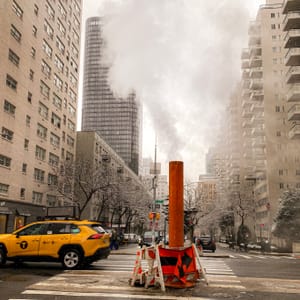New York City has about eight and a half million residents. Most of them live in multi-family buildings; this is the secret to New York City’s low per-capita energy usage, as multi-family buildings are much more efficient to heat and cool. And yet, heating fuels alone account for greater than 50% of the city’s carbon footprint.
The island of Manhattan has around fifty thousand buildings on it. Of those, 1531 are connected to ConEd’s District Steam system. ConEd makes steam at one of six stations around the city and pipes it, via more than a hundred miles of pipe, to these 1531 paying customers, who use it to not only heat but also cool their buildings. The steam is produced in one of a few ways. At the 59th Street station, a former subway powerhouse which now provides twelve percent of ConEd’s district steam, water is simply boiled by burning methane gas – simple enough. The same seems to be the case with the East 60th Street Steam Plant. At the 74th Street Station, the Ravenswood Station, the East River Station at 14th Street, and the Brooklyn Navy Yard, however, steam is produced along with power. Fossil fuels are burned in a turbine, generating electricity; the turbine’s exhaust is passed through a Heat Recovery Steam Turbine to produce steam, which may or may not then be passed through a steam turbine to produce more electricity.
(As a side note: Despite my hopefully obvious disdain for fossil fuels, I kind of love that jet engines – like, literally, engines that are designed for jet planes – can be stripped down, put into a box, and turned into little power plants capable of (at least in this example) providing electricity to a couple thousand homes.)
Wherever and however it’s produced, ConEd says that district steam serves “3 million New Yorkers,” a figure that they clarify refers to “transient population figures” for commercial customers like Madison Square Garden, Grand Central Terminal, and Moynihan Station (the total population of Manhattan is about 1.6 million people, and district steam service only exists below 96th Street). But district steam is just the tip of the iceberg: About three-quarters of NYC’s residential space is heated by steam, the vast majority of which is produced by burning methane gas in on-site boilers.
To their credit, ConEd says that they’d like to move away from methane gas as an energy source for district steam; they suggest that they can use heat pumps to at least preheat water before boiling it, and might be able to use electric boilers as well. But buildings that boil their own steam have a hard time transitioning to electricity as an energy source. My own pet idea is to convert their radiators to hydronic (which is possible, for some configurations) and then use high-temperature heat pumps to provide water around 80°C… which is still a pretty massive project.
SOURCES/SCOPE CREEP.
Read the full story
The rest of this post is for paid members only. Sign up now to read the full post — and all of Scope of Work’s other paid posts.
Sign up now

